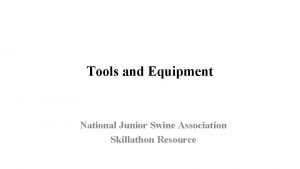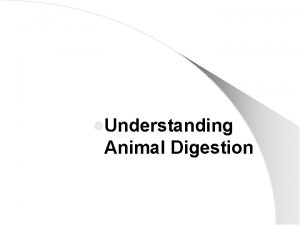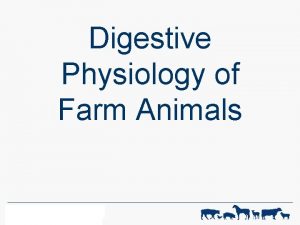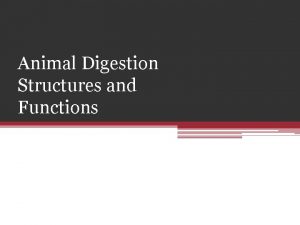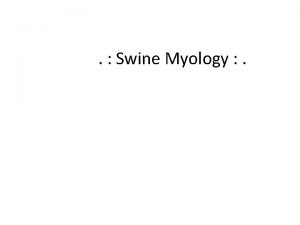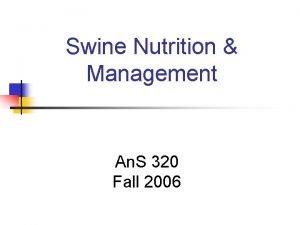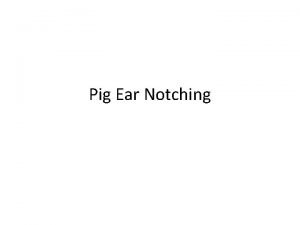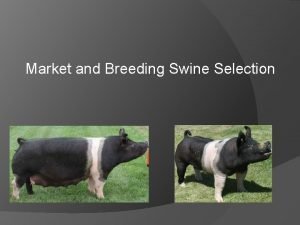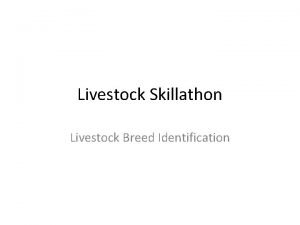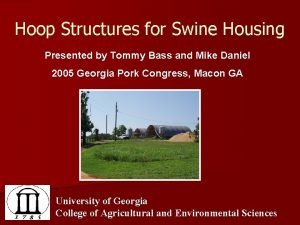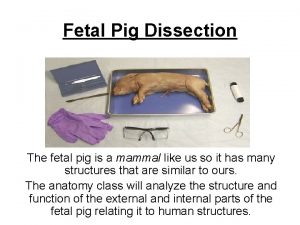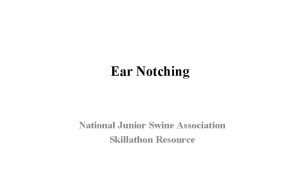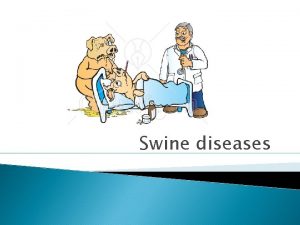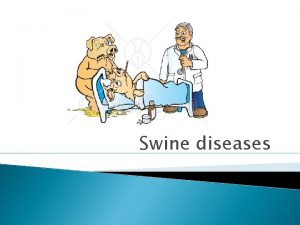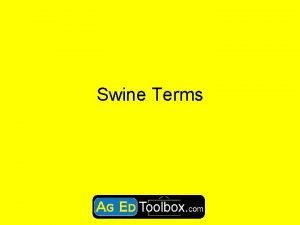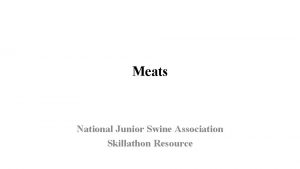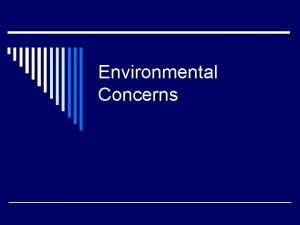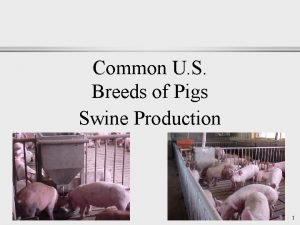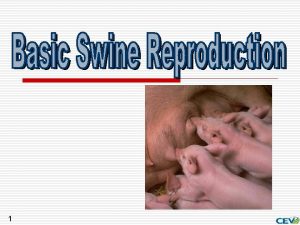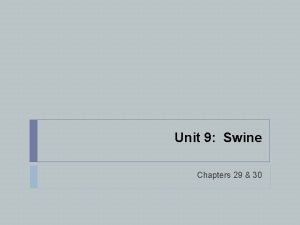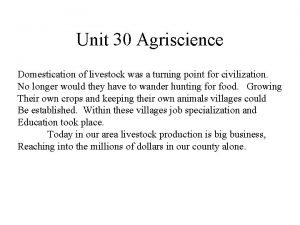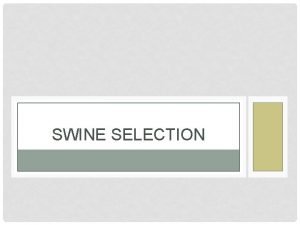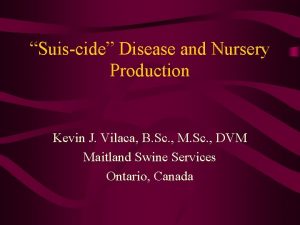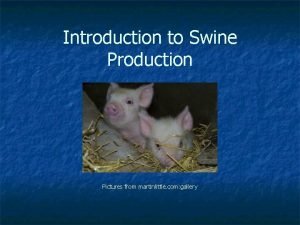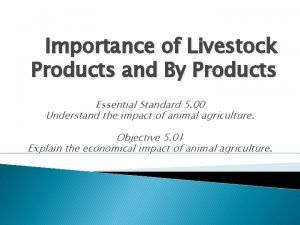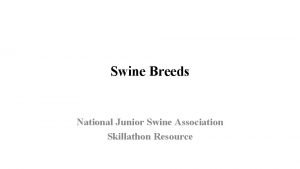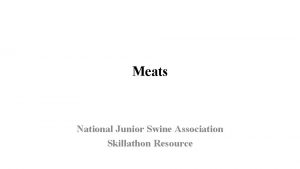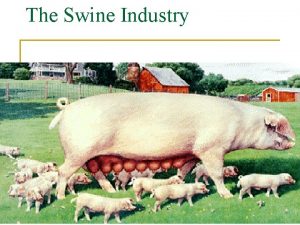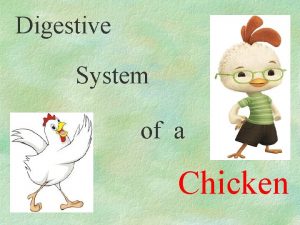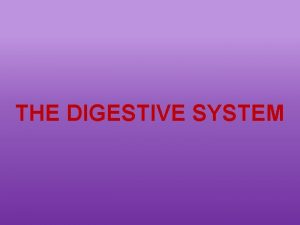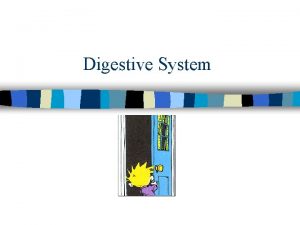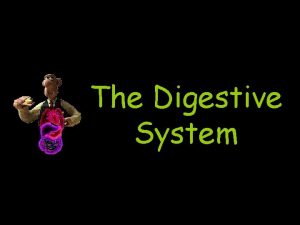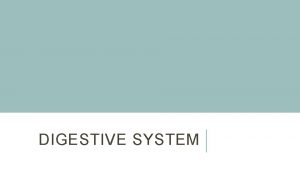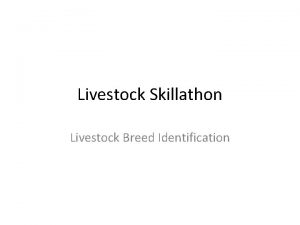Digestive System National Junior Swine Association Skillathon Resource



































- Slides: 35

Digestive System National Junior Swine Association Skillathon Resource

Learning Objectives • Identify various parts of the digestive system. • Explain the difference between a monogastric animal and a ruminant animal. • Explain various functions of parts of the digestive system.

Mongastric vs. Ruminant • A monogastric animal has a single-chambered stomach and a much simpler digestive tract. – Swine are monogastric • A ruminant animal has a four-chambered stomach with a much more complex digestive tract. – Cattle are ruminants

Layout of the Digestive System • Study this diagram to be able to identify the various parts of the digestive system.

Tongue and Salivary Glands • The tongue serves as the first step to generate saliva and it helps push food toward the esophagus. • Sublingual, mandibular, and parotid salivary glands all work together to create saliva. • Saliva is a watery, mucus-like secretion of the salivary glands in the mouth that lubricates the food and aids in digestion. • It contains an enzyme that helps break down starch.

Tongue and Salivary Glands

Esophagus • The esophagus is a tube which carries the food from the mouth to the stomach. • Muscle contractions push the food toward the stomach. • Swallowing is the first of these contractions. • At the end of the esophagus is the cardiac valve, which prevents food from passing from the stomach back into the esophagus.

Esophagus

Stomach • The stomach is a reaction chamber where chemicals are added to the food. • Certain cells along the stomach wall secrete hydrochloric acid and enzymes. – These chemicals help break down food into small particles. • Particles that the stomach cannot absorb into the bloodstream pass in to the small intestine through the pyloric valve.

Stomach

Gall Bladder, Liver, Pancreas, and Duodenum • The gall bladder serves as a storage compartment for bile. • Bile is secreted by a gland called the liver, and bile assists in the digestion of fats. • The pancreas is another gland that secretes juices that aid in the digestion of fats, carbohydrates, and proteins. • These secretions are added in the duodenum, which is the first section of the small intestine.

Gall Bladder, Liver, Pancreas, and Duodenum

Small Intestine and Cecum • The small intestine assists in the absorption of nutrients. • It contains two other parts, the jejunum and the ileum. – The jejunum is the middle or intermediate part of the small intestine. – The ileum is the final portion of the small intestine. • Between the ileum and the large intestine is a “blind gut” referred to as the cecum. • There is no primary role for this in swine, but in some monogastric animals, it aids in the digestions of fibrous materials.

Small Intestine and Cecum Small Intestine

Large Intestine • The large intestine’s main function is the absorption of water. • Mucous is added to the remaining food in order to make passage easier. • The colon is the largest portion of the large intestine and plays a major role in water absorption and formation of feces. • Muscle contractions push food through the intestines.

Large Intestine

Rectum and Anus • The rectum is the final portion of the large intestine. • It is a straight tube of the large intestine that forms solid waste. • The anus is the final part of the digestive tract to excrete undigested food from the body.

Rectum and Anus

Now that you have learned about the digestive tract, take this quiz to see what you have learned! Start Quiz!

1. Pigs are monogastric animals which means they only have a single-chambered stomach. TRUE FALSE

Correct! Keep working through the quiz to see what you know! Next Question

Try Again! Remember to look back in the slides to refresh your memory! Try Again!

2. The jejunum and ileum are a part of the large intestine. TRUE FALSE

Correct! Keep working through the quiz to see what you know! Next Question

Try Again! Remember to look back in the slides to refresh your memory! Try Again!

3. The straight tube that forms solid waste and prepares waste for excretion is called the _______. Anus Rectum Colon Cecum

Correct! Keep working through the quiz to see what you know! Next Question

Try Again! Remember to look back in the slides to refresh your memory! Try Again!

4. At the end of the esophagus is the ______ that helps prevent food from reentry into the esophagus. Cardiac Valve Pyloric Valve Cecum Ileum

Correct! Keep working through the quiz to see what you know! Next Question

Try Again! Remember to look back in the slides to refresh your memory! Try Again!

5. The main function of the liver is to secrete ________. Saliva Juice Water Bile

Correct! Keep working through the quiz to see what you know! End Quiz!

Try Again! Remember to look back in the slides to refresh your memory! Try Again!

Congratulations! You have completed the “Digestive System” resource! Great work! Keep going through the resources to learn more about swine!
 Tools and equipment in swine production
Tools and equipment in swine production Swine digestive system
Swine digestive system Swine digestive system
Swine digestive system Swine digestive system
Swine digestive system Animal digestive system parts and functions
Animal digestive system parts and functions National association of school resource officers
National association of school resource officers Respiratory digestive and circulatory system
Respiratory digestive and circulatory system Fetal pig integumentary system
Fetal pig integumentary system Gastronemus muscle
Gastronemus muscle Arista national junior honor society
Arista national junior honor society National junior honor society essay ideas
National junior honor society essay ideas National junior honor society application answers
National junior honor society application answers Resource loading vs resource leveling
Resource loading vs resource leveling Perbedaan antara resource loading dan resource levelling
Perbedaan antara resource loading dan resource levelling Nervous system and digestive system
Nervous system and digestive system Swine nutrition management
Swine nutrition management Notches in pigs ears
Notches in pigs ears Swine selection
Swine selection Livestock breed identification swine
Livestock breed identification swine Hoop building for hogs
Hoop building for hogs Pig pinna
Pig pinna Swine ear notching worksheet
Swine ear notching worksheet Anatomical planes
Anatomical planes Swine dysentery
Swine dysentery Swine dysentery
Swine dysentery Stag swine
Stag swine Swine wholesale cuts
Swine wholesale cuts Objectives of swine production
Objectives of swine production Common breeds of swine
Common breeds of swine Swine dummy sows
Swine dummy sows Objectives of swine production
Objectives of swine production Livestock breed identification: swine - vocabulary
Livestock breed identification: swine - vocabulary External part of swine
External part of swine Suiscide hotline
Suiscide hotline Swine production introduction
Swine production introduction Livestock breed identification swine - vocabulary
Livestock breed identification swine - vocabulary
